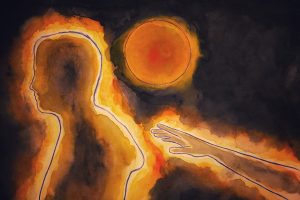
The Age of Extinguished Reason
by Salil Patel | July 20, 2017
We have not always had light.
According to Hesiod’s epic poem, ‘Theogony’, the luxury of light was hidden by Zeus as a cruel punishment for deception. Prometheus, in an act of treachery, stole fire from Mount Olympus by smuggling a lit torch to mankind. His punishment was eternal – chained to a mountain with eagles feasting on his perpetually regenerating liver. But humanity had rediscovered fire, heat and light, and with these came progress and revolution.
Although fictitious, the prelude of knowledge to revolution, in the form of scientific discovery such as Hesiod’s light, is historically ubiquitous.
The stretch of time between 1685 and 1815 has come to be known as the Age of Reason. Others prefer a more romantic term harking back to ancient Greece: the Enlightenment. A mesh of philosophical and scientific prowess came to the fore with Kant, Galileo, Hume, Leibniz and Boyle to name a few. Newtonian laws replaced alchemy. Copernican astronomy displaced astrology. The subjects ranged drastically but each was bound together by the simple premise – our universe could be rationalised. Such an eruption of concentrated expertise was described by Voltaire as “a chaos of clear ideas”.
This genesis of ideas forged great political upheaval. The academic dexterity across the Atlantic inspired previously unheard of pro-revolutionary philosophical rhetoric against the throne and altar. In Philadelphia of early 1776, the Englishman Thomas Paine, galvanised by a combination of Newtonian rationalism and Quakerism, published a pamphlet entitled ‘Common Sense’, which came to be widely circulated.
“Should an independency be brought about by the first of those means, we have every opportunity and every encouragement before us, to form the noblest, purest constitution on the face of the earth” he wrote, “we have it in our power to begin the world over again.”
The philosophy of John Locke (a physician by trade), which encapsulated natural rights and social contracts, was well regarded amongst the founding fathers. Thomas Jefferson went one step further than most and proclaimed that Locke, along with Francis Bacon and Isaac Newton, were the three greatest men who had ever lived. Locke’s premise that all individuals had a right to “life, liberty and property” was only slightly tweaked by Jefferson, who framed “life, liberty and the pursuit of happiness” as examples of unalienable rights, in the Declaration of Independence.
This rhetorical framework laid the foundations for Jefferson to draft the Declaration of Independence. On the fourth of July 1776, the declaration was signed. By the end of the year, reprints had emerged throughout Europe and South America influencing subsequent independence in a multitude of nations, including much of nineteenth-century South America and, most recently, the Rhodesian declaration of 1965.
It is not novel to argue that scientific revolutions are a common precursor to shifts in the political landscape. However, change is easier to pinpoint with the luxury of hindsight. The Enlightenment inspired the founding fathers. The founding fathers inspired Lafayette. Lafayette, with help from Paris-dwelling Jefferson, drafted France’s answer to the US declaration, the ‘Declaration of the Rights of Man and of the Citizen’. This would spark the storming of the Bastille and subsequent French Revolution, thirteen years after the signing of the Declaration of Independence. History repeats as science ceaselessly strives.
We live in such a time of striving. Thousands look skyward with the aim of colonising Mars. We have moved from mapping our world to mapping our genome. With it comes the possibility of personalised medicine. Artificial intelligence is primed to overtake humans in pure intellect and astonishingly, intuition – something inconceivable a few decades ago.
Our political climate is also in a state of flux. The Trumps, Farages and Le Pens are known quantities. But in their shadows lay many others. The “bullets, beef and Bible” (BBB) caucus in Brazil are an increasingly dominant political fraction, successfully steering public conversation, on a multitude of topics from abortion to the deforestation of indigenous land, to the far-right. The Rab’a Massacre of 2013 – where approximately 1000 protestors were slaughtered over the course of a day – was orchestrated by Abdel-Fattah al-Sisi. He is now president of Egypt. From the relative security of centrism, electorates around the world are increasingly turning toward radical wings to placate visceral fears.
Despite scientific endeavour improving the three axioms of ‘security, success and stability’ over the past century, politics is seen by many as the mystic chords orchestrating change, the antithesis of what Rousseau classed as natural harmony. Instead of electing the most scientifically literate, heirs to Jefferson and Paine, we elect those without any pedigree. Facts are remnants of a bygone era. Experts are dismissed. This is a time of style over substance.
The public perception of facts ebbs and flows like a sine wave weaving its way through history. Mass distrust of reason can occur soon after the pinnacle of intellectualism; take the Sack of Rome by King Alaric I, in 410AD, where academia dramatically fell in societal status following the collapse of the Western Roman Empire.
So has it now. Trust should not be placed with manufactured politicians, packaged with ribbon topped pride, candied with fragility. Instead we ought to look toward those who strive for more, those who look at the universe and feel a need to add, not just to a great body of knowledge, but to our way of thinking: scientists, philosophers and artists. These are nature’s luminaries, enlightening falsehoods. Prometheus reincarnated for our time.
Illustration: Niamh Simpson




